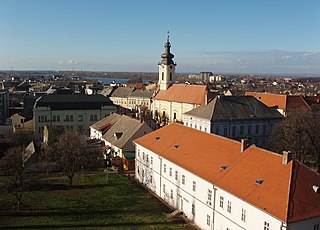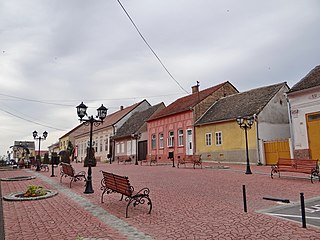Related Research Articles

Sremska Mitrovica is a city in Serbia. It is situated on the left bank of the Sava river. As of 2022, the city has a total population of 40,144 inhabitants, while its administrative area has a population of 72,580 inhabitants.

Arius was a Cyrenaic presbyter and ascetic. He has been traditionally regarded as the founder of Arianism, which holds that Jesus Christ was not coeternal with God the Father, but was rather created before time. Arian theology and its doctrine regarding the nature of the Godhead held in common a belief in subordinationism with most Christian theologians of the 3rd century, with the notable exception of Athanasius of Alexandria.

Syrmia is a region of the southern Pannonian Plain, which lies between the Danube and Sava rivers. It is divided between Serbia and Croatia. Most of the region is flat, with the exception of the low Fruška gora mountain stretching along the Danube in its northern part.

The Srem District is one of seven administrative districts of the autonomous province of Vojvodina, Serbia. It lies in the geographical regions of Srem and Mačva. According to the 2022 census results, it has a population of 282,547 inhabitants. The administrative center is the city of Sremska Mitrovica.

Sirmium was a city in the Roman province of Pannonia, located on the Sava river, on the site of modern Sremska Mitrovica in the Vojvodina autonomous province of Serbia. First mentioned in the 4th century BC and originally inhabited by Illyrians and Celts, it was conquered by the Romans in the 1st century BC and subsequently became the capital of the Roman province of Pannonia Inferior. In 294 AD, Sirmium was proclaimed one of four capitals of the Roman Empire. It was also the capital of the Praetorian prefecture of Illyricum and of Pannonia Secunda. The site is protected as an archaeological Site of Exceptional Importance. The modern region of Syrmia was named after the city.

Mačva is a geographical and historical region in the northwest of Central Serbia, on a fertile plain between the Sava and Drina rivers. The chief town is Šabac. The modern Mačva District of Serbia is named after the region, although the region of Mačva includes only the northern part of this district. A small northern part of Mačva region is in the Autonomous Province of Vojvodina, in the Syrmia District.
The Acacians, or perhaps better described as the Homoians or Homoeans, were a non-Nicene branch of Christianity that dominated the church during much of the fourth-century Arian Controversy. They declared that the Son was similar to God the Father, without reference to substance (essence). Homoians played a major role in the Christianization of the Goths in the Danubian provinces of the Roman Empire.
In 294 AD, Sirmium was proclaimed one of four capitals of the Roman Empire. The Councils of Sirmium were the five episcopal councils held in Sirmium in 347, 351, 357, 358 and finally in 375 or 378. In the traditional account of the Arian Controversy, the Western Church always defended the Nicene Creed. However, at the third council in 357—the most important of these councils—the Western bishops of the Christian church produced an 'Arian' Creed, known as the Second Sirmian Creed. At least two of the other councils also dealt primarily with the Arian controversy. All of these councils were held under the rule of Constantius II, who was eager to unite the church within the framework of the Eusebian Homoianism that was so influential in the east.
Semi-Arianism was a position regarding the relationship between God the Father and the Son of God, adopted by some 4th-century Christians. Though the doctrine modified the teachings of Arianism, it still rejected the doctrine that Father, Son, and Holy Spirit are co-eternal, and of the same substance, or consubstantial, and was therefore considered to be heretical by many contemporary Christians.

Sermon was an early 11th-century voivode (duke) of Syrmia and a local governor in the First Bulgarian Empire, vassal of Bulgarian emperor Samuil. His residence was in Sirmium. He was described in Byzantine sources as: "ruler of Syrmia and brother of Nestongos".
The Council of Seleucia was an early Christian church synod at Seleucia Isauria.
Photinus was a Christian bishop of Sirmium in Pannonia Secunda, best known for denying the incarnation of Christ, thus being considered a heresiarch by both the Catholic and Orthodox Churches. His name became synonymous in later literature for someone asserting that Christ was not God. His teachings are mentioned by various ancient authors, like Ambrosiaster (Pseudo-Ambrose), Hilary of Poitiers, Socrates Scholasticus, Sozomen, Ambrose of Milan, Augustine of Hippo, John Cassian, Sulpicius Severus, Jerome, Vigilius of Thapsus and many others.
The fourth-century Arian controversy was a series of Christian disputes about the nature of Jesus Christ.
“The crisis of the fourth century was the most dramatic internal struggle the Christian Church had so far experienced”.

The Ecclesiastical History, also known as The History of the Church and Church History, is a 4th-century chronological account of the development of Early Christianity from the 1st century to the 4th century, composed by Eusebius, the bishop of Caesarea. It was written in Koine Greek and survives also in Latin, Syriac, and Armenian manuscripts.
Ursacius was the bishop of Singidunum, during the middle of the 4th century. He played an important role during the evolving controversies surrounding the legacies of the Council of Nicaea and the theologian Arius, acting frequently in concert with his fellow bishops of the Diocese of Pannonia, Germinius of Sirmium and Valens of Mursa. Found at various times during their episcopal careers staking positions on both sides of the developing theological debate and internal Church politicking, Ursacius and his fellows were seen to vacillate according to the political winds.
Cecropius of Nicomedia was a bishop of Nicomedia and a key player in the Arian controversy.
Valens of Mursa was bishop of Mursa and a supporter of Homoian theology, which is often labelled as a form of Arianism, although semi-Arianism is probably more accurate.
Arian creeds are the creeds of Arian Christians, developed mostly in the fourth century when Arianism was one of the main varieties of Christianity.

Dušan Popović was a lawyer and politician in Croatia. He was a leading member of the Croat-Serb coalition in the Croatian Parliament and a delegate to the Hungarian House of Representatives.

The Museum of Srem in Sremska Mitrovica is the city institution focused on the research, preservation and presentation of historical objects and artifacts related to the Syrmia region. The museum was officially established in 1946 under the name of the City Museum of Sremska Mitrovica shortly after the end of World War II in Yugoslavia and the liberation from the Axis occupation of Vojvodina.
References
- ↑ Ivanović, Aleksandar. Spisak episkopa Sirmija uz kratke beleške[List of bishops of Sirmium with short notes] (in Russian). p. 5.
- ↑ Ненад Лемајић, Хронотакса црквених достојанственика у Срему[The Chronotaxis of Church Dignitaries in Srem]. Proceedings of the Srem Museum (in Russian). Srem Museum, Sremska Mitrovica. 1997. p. 60.
- ↑ Socrates Scholasticus (16 October 2019). "30". Church History. Vol. 2. Lulu.com. ISBN 978-0-359-86527-7.
- ↑ Socrates Scholasticus (16 October 2019). "37". Church History. Vol. 2. Lulu.com. ISBN 978-0-359-86527-7.
- ↑ This document mention one more heresiarch among the bishops of Sirmium (metropolitan bishops of Pannonia Secunda), Photinus. For Photinus of Sirmium and his teachings about nature of Jesus, see: Ivanović, Aleksandar. Fotin Sirmijumski i njegov nauk- novi pokušaj rekonstrukcije fotinističke Hristologije [Photinus of Sirmium and his Doctrine- New Attempt of Reconstruction of Photinian Christology] (in Russian). p. 1.